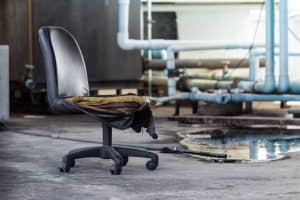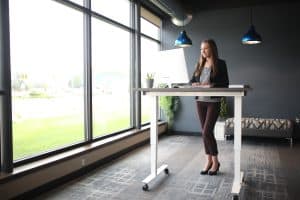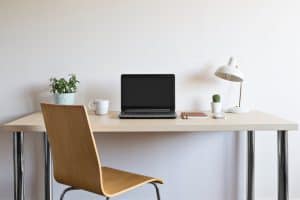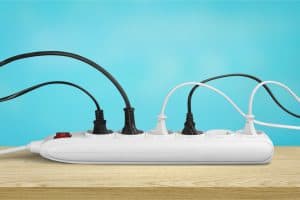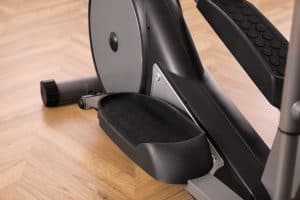A home office is like a sanctuary. It’s a personal space where you go to be alone with your mind to focus on your craft, and it should serve as a perfect spot that fits all your needs. This is why the design of your home office is of great importance.
A good workspace should be comfortable and cozy enough to motivate and inspire you to be productive but thoughtfully designed so that you don’t get too comfortable and fall asleep. There’s a fine line between the two, and we’re here to teach you how to strike the perfect balance so that you can get the most out of your home office.
In today’s post, we’ll share our best tips on how to design your home office in the most efficient way, and the best way to do that is to start with the centerpiece: your desk.
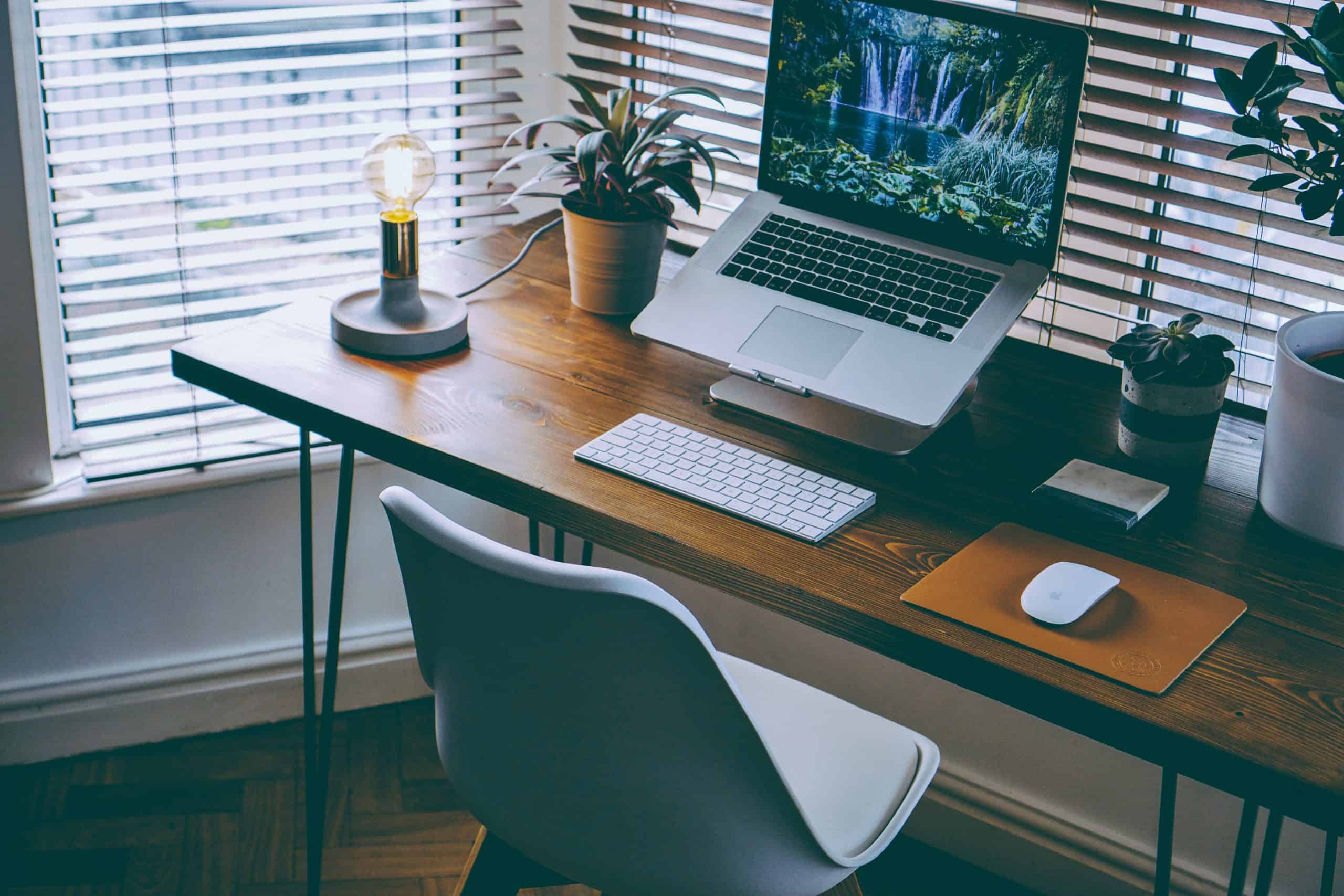
Where to Position Desk in Home Office
As we said, the position of your desk matters a lot when it comes to working efficiently, and it also has a huge effect on your mood as well.
Studies suggest that the positioning of your desk and its location in relation to the space it’s in has a great effect on focus and work productivity. Factors such as the view you regularly look at, the direction from which the light cascades onto you, and whether your back is against the wall or not all have a tremendous effect. Research has even found a correlation between work-related stress and the design of the workspace.
Whether you’re working from home and want to optimize your space, or if you’re designing a home office from scratch, you’ll benefit from our tips on how to position desks in home offices and how to design a home office in general. Let’s start by taking a look at what to consider when placing your desk in your home office; then, we’ll move on to our tips to set up a good home office.
Where to Put a Desk: Things to Consider
Here are some of the factors you should consider when placing a desk in your home office.
Desk Location
The location of your desk is the most important thing when it comes to designing a home office. After all, it’s where you’ll be sitting for hours and hours on end, and where you are positioned in relation to the room makes a big difference.
Let’s start by saying that in an ideal room that has good natural lighting and sufficient space, the best positioning for your desk is in the center of the room and slightly to the back. This way, you’ll be able to utilize the space behind you for keeping things you need within reach and still have most of the room visible in front of you. It creates a sense of control over the space, and the centered desk clearly sets the purpose and the tone of the room.
If you have a small space for a home office, on the other hand, it’s best to position your desk next to or against a wall, rather than having it in the center of the room. This is a much more efficient way to utilize your space.
If you place your desk against or next to a wall, you can free up some space on your desk by installing shelves on the wall. Keeping your personal objects such as family photos and small figurines, or things you don’t need too frequently up on a shelf on the wall can be a great idea if you’re working with a small desk.
Design of the Room
As we said, the best positioning for your desk is the center of the room, but that’s only applicable if your space has natural lighting with windows and if the room has a convenient shape. By this, we mean a square or a rectangular room, which is the easiest to decorate.
If the room you’re using as a home office isn’t shaped like a perfect box and has lots of nooks and indentations, utilizing these nooks is a great idea. Placing your desk against a nook if it’s big enough or placing it nearby if it’s not will allow you to utilize a dead space that you otherwise wouldn’t be able to use.
If you can’t place your desk inside the nook, try placing it next to it, and you can put a file cabinet in there. You can use the space on top as a small table, and you can merge it with your desk to create your own desk return! If you want to learn more about desks that feature a return, you can check out our recent post on what is a desk return.
Tips for Designing a Better Home Office
Good Lighting Is a Must
If you’ve ever worked under brutally bright fluorescent lights, you probably know how important good lighting is, not just for efficiency but for keeping your sanity as well. In contrast, a space that’s too dimly lit may cause you to relax a bit too much and fall asleep. Not that there’s anything wrong with that, as we explored in one of our posts, but it’s not ideal if you intend to get work done in your office.
Science suggests that proper lighting not only increases productivity but is also important for our mood and emotional stability. You can find the best lighting by trial and error, but you can’t go wrong with lighting that resembles natural sunlight. A survey among employees found that natural lighting is the best luxury an office space can have.
Alternatively, if you don’t have free space to place a desk lamp, you can also use LIBORA LED Desk Lamp with Clamp, Eye-Caring Reading... that can be attached to your monitor or your desk. LED lights are a great alternative to traditional desk lamps as they are much smaller and can illuminate your desk just the same.
Declutter to Focus Better
We get it. A completely sterile desk feels like you’re working at a desk in an IKEA showroom, but having too much stuff on your desk can also hurt your productivity. Science says that visual clutter hurts our focus greatly, and the solution is quite simple.
Basically, the clutter you’re looking at competes with the thoughts in your brain for the same limited attention capacity. This means that the less stuff you’re constantly looking at, the more space there is for your thoughts and ideas!
As we said before, centering your desk so that you see the rest of the room is a good idea, but if your room is messy, this may work against you. Keeping things out of sight by placing them in boxes, drawers, and filing cabinets is a good idea. If you want to learn more about how to organize and declutter your office, you can head over to our post, where we share our best tips and ideas to organize and optimize your office space.
Get a Good Office Chair
The office chair you’ll use might be the most important aspect of your home office. Working involves long hours of sitting motionless, and if you’re not careful, your chair can do more harm than it can help.
To optimize the time your spend at your home office, getting a good, ergonomically designed office chair is a must. Here are some of the most important points that make a chair ergonomic:
-
- Recline functionality: The ideal sitting position requires your thigh-body angle to be 10-30 degrees past the right angle, which is why having a reclining chair is important.
- Lumbar support: The lumbar region is the inward curve in your lower back that’s above the tailbone. This area needs to be supported to maintain a neutral spine position, so look for a chair with a lumbar pillow or adjustable lumbar support.
- Backrest with neck support: For correct spinal alignment, you also need neck support. Chairs with a high backrest and good neck support can prevent chronic neck and upper back pain.
- Adjustable armrests: Armrests provide extra support for your spine, and it takes the pressure off your shoulder to help keep your spine in a neutral position.
- Adjustable height: Ideally, you should be sitting at a height where you’re comfortable with your feet on the ground, and your knees bent at a 90-degree angle. This is the best position for your posture, and it can help alleviate chronic back pain.
If you want to learn more about ergonomic chairs and what exactly they are, you can check out our post on ergonomic office chairs. You can also take a look at the Duramont office chair, a great example of a good-quality ergonomic office chair that we have reviewed.
Populate With Plants
This might not have anything to do with where to put desks in offices, but it’s still a great tip that will definitely make a difference. Plants in your office space can turn an otherwise bleak and lifeless room into a living, breathing, vibrant space.
Don’t forget that plants also provide you with oxygen. If your home office doesn’t exactly have the best air conditioning, keeping a plant or two around can help significantly. You can even keep small plants or flowers on your desk to bring some color to your workstation.
Add a Personal Touch
We talked about why you should keep as little stuff around as possible, but there’s always room for a personal touch. You can keep a few personal items on your desk, like photos of your loved ones or small memorabilia to remember precious moments. Having these objects might actually motivate you to work more efficiently instead of being a distraction.
Be careful, however, as this can get out of hand rather fast. One picture can quickly turn into a whole album of photos on your desk. You may also be tempted to put more stuff on as time passes, which may lead to an overcrowded desk. Decluttering can be especially hard since items have symbolic value and are connected to your memories or emotions.
Conclusion
In today’s post, we explained where to put a desk in your home office and also shared our best tips on how to design your home office for efficiency. In a rectangular room, your desk should be in the center of the room, slightly to the back.
If you don’t have an optimal space, however, you can also utilize nooks in your room and place your desk nearby or against the nook to use your space more efficiently. Moreover, you can improve the space even more by having good lighting and decluttering. Having an ergonomic office chair and adding personal items and plants to your environment can also be a nice touch.
We’re at the end of our post, but you might still be dissatisfied with your desk and want to optimize it even further. You can find further tips in our detailed post on how to organize your desk.
